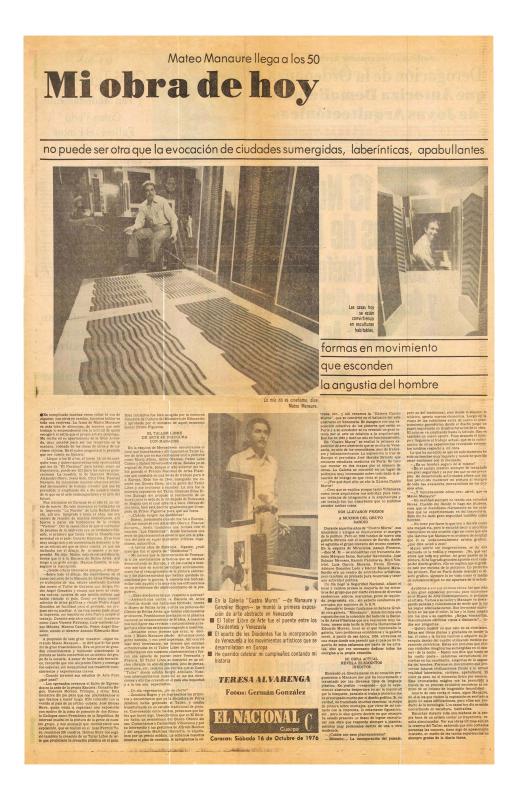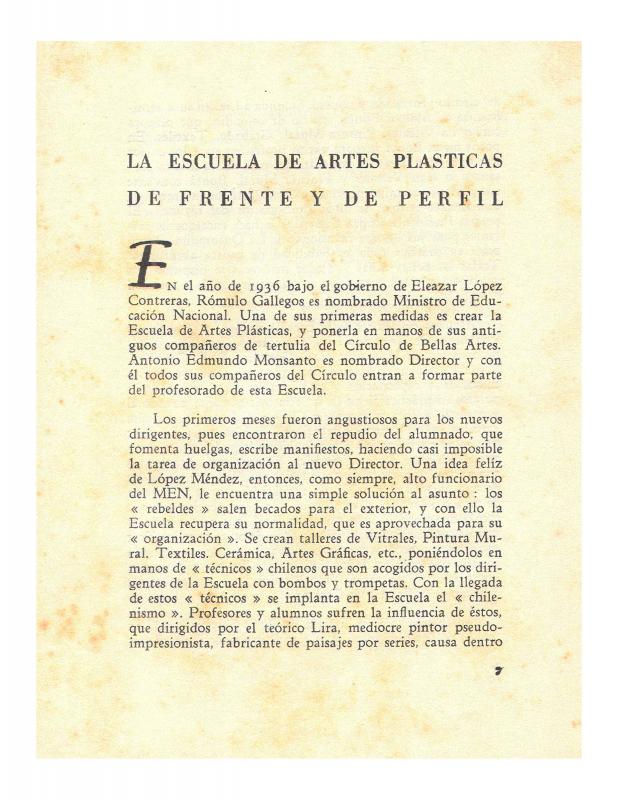During the years renowned Cuban writer Alejo Carpentier (1904–80) lived in Venezuela (1947-59), he was an advocate of new artistic tendencies and of contemporary music. He was closely tied to the Taller Libre de Arte (TLA, 1948–52), which produced most of the artists who questioned both traditional landscape painting and the social realism that was beginning to take root in Venezuela. Carpentier’s tone is not polemic but conciliatory as he attempts to bridge extreme stances; his language is more akin to journalism than to the essay. Carpentier defends the legitimacy of the ideas put forth by the young (abstract) artists exhibiting work at the Cuatro Muros gallery. His passing historical references might be an attempt, on the one hand, to relativize the absolute innovation of abstract art and, on the other, to formulate an approach more visual than ideological and, thus, in keeping with the geometric architecture of the time. The most striking aspect of Carpentier’s unbiased argument is the call to look for the visual values in all works of art rather than for the intentions that underlie them. In this sense, his position represents a middle ground between the battling tendencies of social realism and of abstraction. Alexis Márquez Rodríguez’s Letra y Solfa (Caracas: Síntesis Dos mil, 1975)—a compilation of the articles Carpentier published while he was in Venezuela in a column of the same name—did not include this article.
For texts on Manaure’s work, see Víctor Guédez’s “La creación estético-visual en Mateo Manaure” (ICAA digital archive doc. no. 1155531); Roberto Guevara’s texts “Manaure y la inmensa noche” (doc. no. 1156411), “Manaure: Columnas en tierras movedizas” (doc. no. 1155301), and “Manaure y las Cuvisiones” (doc. no. 1156459); Perán Erminy’s “Las imágenes poéticas de Manaure” (doc. no. 1156523); Alfredo Boulton “Mateo Manaure en el Museo de Bellas Artes” (doc. no. 1157497); Gastón Diehl’s “Mateo Manaure” (doc. no. 1156491); Teresa Alvarenga’s article “Mi obra de hoy: Mateo Manaure llega a los 50 años” (doc. no. 1156427); Pedro Lhaya’s article “Mateo Manaure o la autenticidad pictórica americana” (doc. no. 1156443); Gloria Carnevali’s essay “El color a través de Mateo Manaure” (doc. no. 1155499); and Manaure’s own “La Escuela de artes plásticas de frente y de perfil” (doc. no. 813569) on the history of the Escuela de Artes Plásticas de Caracas, as well as his “La decisión de un artista” (doc. no. 1156475), in which the artist announces his decision to build a studio near his hometown of Uracoa.












